Rhubarb gives me stress. Which I realize is weird, but it’s true: I find it to be a stressful plant. This is a fairly new problem, brought on by purchasing our house three years ago. Before, rhubarb was an innocuous fruit/vegetable, sitting redly/greenly on a table at the farmer’s market. What a folkish springtime delight! But after our first winter here, when the spring erupted in our (massively overgrown) backyard, we discovered rhubarb amid the burdock and bamboo and stinging nettles and ferns and goldenrod. (Like I said: massively overgrown.)
And when you have rhubarb growing in your backyard… Look. I’m not one to look a gift horse in the mouth, and it is very nice to have a spring crop that we do literally nothing to cultivate. It’s like a gift from the earth. But when you have a rhubarb plant in your backyard you have to do something with it, because it would be a waste not to, a rejection of the bounty of the gods. But… I didn’t grow up eating rhubarb, so my repertoire’s a little limited, and I can only make so many pies and crumbles, and the stalks just. keep. growing.
So I put ’em in scones. Scones, my friends, are little bits of magic that you can hide things in. Scones are hunks of biscuity dough where your problem fruits go to live a happy life. Got a half-pint of blueberries lingering? Scones. Overbought Zante currants and the dried fruit drawer’s a little full? Scones. Last of the withered fall apples and a scraggly bit of cheddar? Scones.
But please, let us be clear: though I started off making rhubarb scones out of desperation, there’s absolutely nothing desperate or unwilling about my eating of these rhubarb scones. The dough is chockfull of butter and rich with the tang of buttermilk. It has a bare sweetness from brown sugar and vanilla, and the toasty brown crust cracks quickly to a tender, moist crumb. But the rhubarb! Oh, the rhubarb.
Here’s the thing: rhubarb is a little too sour for most people to eat out of hand (though if you’re a fan of candies like Sour Patch Kids, you should try just dipping the cut end of a stalk in sugar and chomping down, which is revelatory). But if you let it sit for just a few minutes, sprinkled with sugar, it changes ever so slightly. The acidity is still there, but it’s tamed and softened. And when you fold these delicate little slices of sugared rhubarb into such a nice dough, you get a match made in heaven: barely sweet bread, rich and satisfying, with plenty of little nubbins of rosy-pink excitement.
Watch out, backyard rhubarb plant: I’m comin’ for ya.
Rhubarb buttermilk scones
These scones are a study in contrasts: crunchy brown crust and soft, tender crumb. Pale yellow bread and rosy pink rhubarb. Barely sweet dough and slightly tart fruit. For breakfast, tea, or midnight snack, they now have a guaranteed spot in my seasonal menu.
For best results, do slice the rhubarb quite thin; too thick and it makes the dough soggy.
Adapted from a recipe for Buttermilk Scones, from Chad Robertson of Tartine, posted at The Splendid Table’s website.
Ingredients
8 oz. rhubarb, sliced very thin (less than a quarter-inch thick)
3 Tbsp sugar
4 1/2 c all-purpose flour
1 Tbsp baking powder
3/4 tsp baking soda
1/2 cup brown sugar
1 1/2 tsp kosher salt
1 c cold butter (2 sticks)
1 1/2 c buttermilk
1/2 tsp vanilla
2 Tbsp melted butter
Sugar for dusting
Directions
Before you do anything else, even before you preheat the oven, toss the sliced rhubarb with the 3 Tbsp of sugar and set aside to macerate. Then preheat oven to 400°F.
Combine the flour, baking powder, baking soda, brown sugar, and salt in a large bowl. Using your hands or a pastry blender, break up the brown sugar so it no longer has any clumps. If your kitchen is very warm, stash the bowl in the freezer for a few moments while you cut the butter.
Cut the butter into small pats or cubes and add to the flour mixture. Using your fingertips or a pastry blender, cut the butter into the flour until all the bits are pea-sized or smaller. (Don’t break it all the way down to homogeneity; you want some pea-pieces to keep the dough tender). If the oven isn’t preheated yet, stash the bowl in the freezer again.
Drain the rhubarb — if you like, you can save the syrup for flavoring drinks, drizzling on scones, whatever — and toss it with the flour mixture, then add the buttermilk and vanilla. Stir together until no dry flour remains. Use your hands to push everything together into a cohesive mass, but do not knead. At most, gently fold in half a few times (which will have the side effect of giving you distinct layers in the finished product).
Turn out onto a lightly floured surface and shape. You have two shaping options:
1. Pat the dough out into a single rectangle, roughly 12″ by 8″, and cut into twelve triangles with a chef’s knife (think of this as cutting the rectangle into 6 squares, and then cutting each square in half; see photo above).
2. Divide the dough in half and pat each half into a circle roughly 8″ in diameter, then cut like a pie into 6 even wedges. Honestly I’ll probably do this in the future; the rectangle was finicky and I had trouble creating well-defined edges.
Place the cut scones on a baking sheet (I determined in later testing that there’s no need to line the sheet, despite the photos above). Brush with the melted butter and dust with sugar, then bake for about 25 minutes, until nicely browned on top.
Serve as you like: plain, with butter, with clotted cream, with a drizzle of reserved syrup. (Or my usual: snatched off the counter in the morning rush and eaten while walking to work.)
Options
There’s no particular reason these need to be made with rhubarb; the recipe I adapted for the base calls for Zante currants, and also notes that frozen berries (cut, in the case of strawberries) would be fine. No need to macerate in those cases; that’s just for rhubarb’s special tartness.


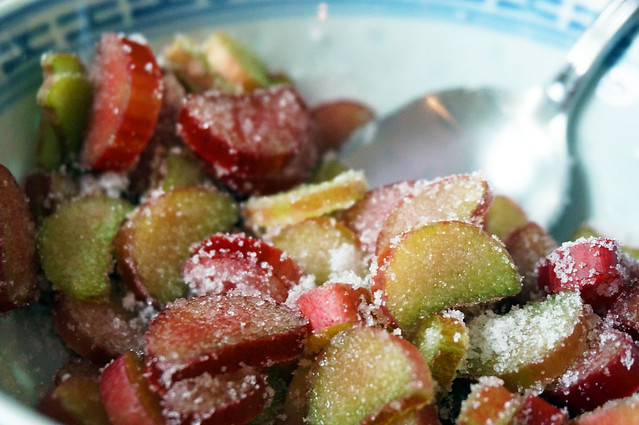
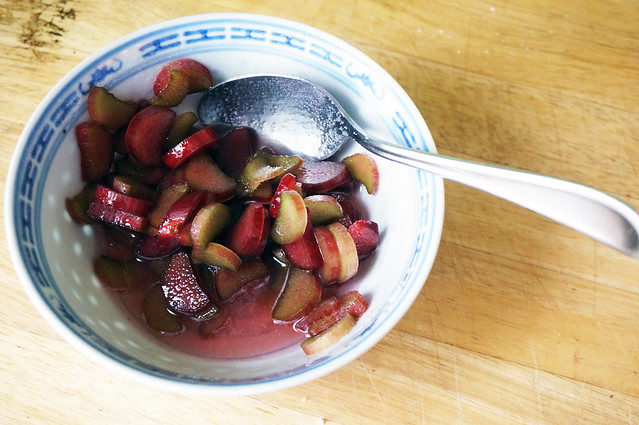
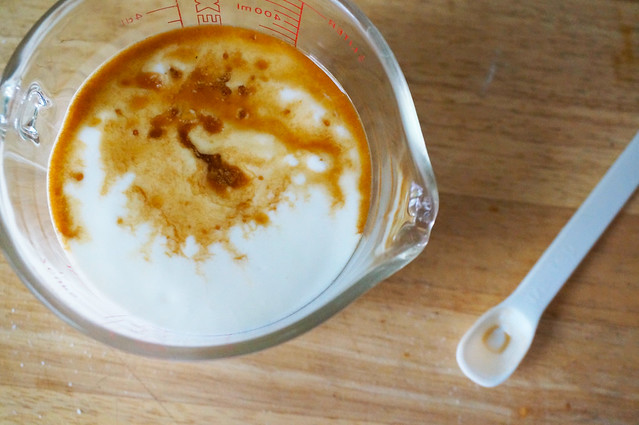

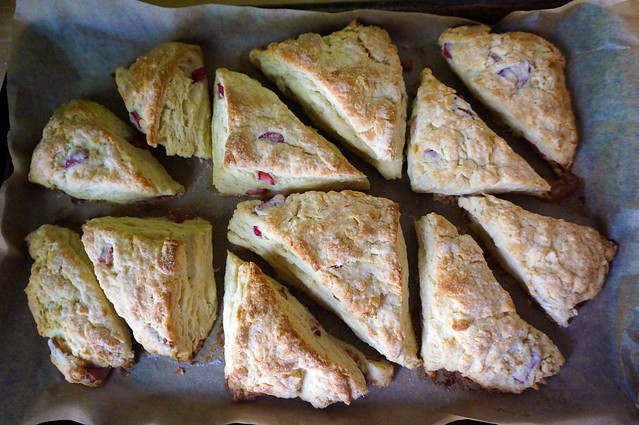
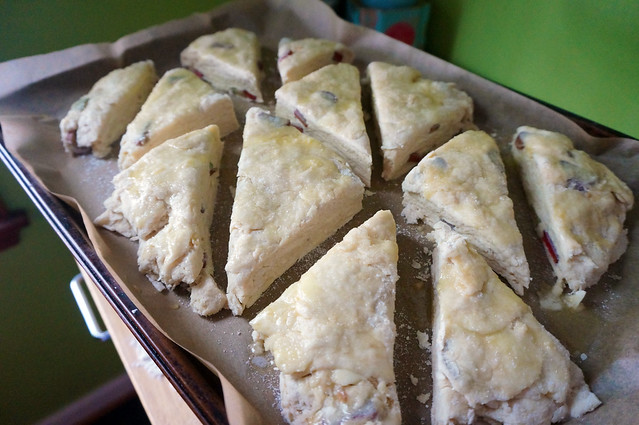
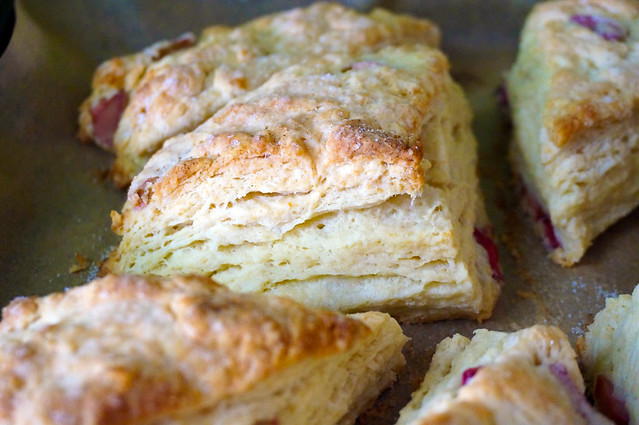


When I was a kid, Lemon Heads were my favorite candy. I would eat lemons and limes with gusto. And thus it should be no surprise that one of my favorite things about visiting my grandmother every summer was rhubarb. She made rhubarb pie, rhubarb jam, rhubarb cobbler, and even a little rhubarb sauce which was great for dipping your food in. Yum!
Basically, I suspect that I shall adore this recipe.
It has a lot to live up to, sounds like, but I think it just might.